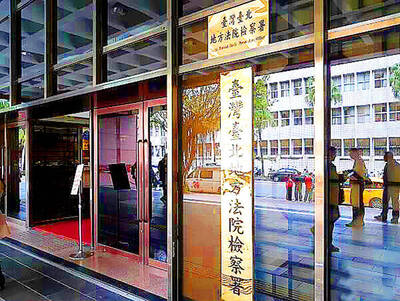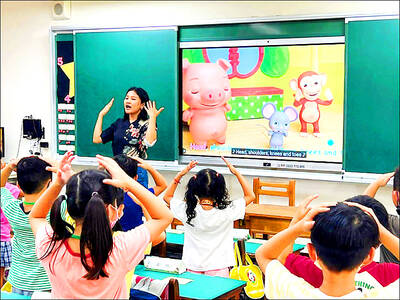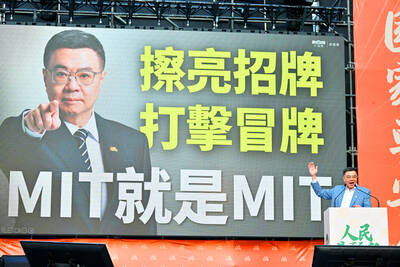There just isn't enough evidence to support the increasingly popular hypothesis that Asian economies are "decoupling" from a slowing US.
Markus Rosgen, who is Citigroup Inc's chief Asia strategist in Hong Kong, says the notion that the region has its own self-sustaining growth and doesn't have to sink or swim with the US "is a case of hope over reality."
The ratio of consumption in Asian nations' GDP, he says, has declined over the last five years.
While the US share of Asian exports has fallen -- to 17 percent last year from 23 percent in 1985 -- the intra-Asian trade that has replaced it moves in lockstep with US imports.
The correlation between the growth in intraregional Asian exports and US non-oil imports has increased sixfold in the past 25 years or so, Rosgen's analysis shows.
Ditto for the flow of capital: Stock indexes in Asia are more linked with US -- and European -- benchmarks now than they have been in 30 years, Rosgen says.
Even US patent records show that Asia's decoupling from the West is going to be a long-drawn process.
The flow of knowledge isn't getting the attention it deserves in the decoupling debate, which remains largely focused on movements of trade and capital. This is odd considering that throughout history the rise of new economic nerve centers has essentially been triggered by spurts of innovation.
K-WAVES
Economist Joseph Schumpeter called them K-waves, in honor of the Russian academic Nikolai Kondratiev, who devised a theory of 50-year-long business cycles of booms and busts.
George Modelski, a University of Washington political scientist, says the maturing of printing techniques in China in the 10th century was the first K-wave, while the arrival of Intel Corp's microprocessors in the early 1970s is the starting point of the 19th -- and the most recent -- one.
All the waves have started as concentrated bursts of activity that gradually spread in all directions; their primary effect has been to make the host economy rich for two generations, or about 50 or 60 years, and then dissipate.
Viewed from this prism, the brisk economic activity in Asia that is being touted as proof of decoupling may be just what one would expect to see in the diffusion phase of a disruptive technology -- such as the Internet -- - that was hosted elsewhere.
Together with excess telecommunications capacity created during the dot-com bubble, the Internet has made it possible for many tasks -- from analysis of X-ray reports to remotely monitoring the shop-floor inventory at a Detroit automaker -- to be outsourced to the Asian region cost-effectively. Yet, outsourcing is still about satisfying final Western demand.
US PATENTS
The current technological cycle won't make Asia a new economic powerhouse; it may set the stage, but the spark will have to come from within. What that innovation might be remains unknown. However, after it does arrive, it will be seen -- with the benefit of hindsight -- as a new 20th wave, or K-20.
What we are witnessing now is the buildup phase of Asia's scientific prowess. Analysis by Albert Hu, an economist at the National University of Singapore, shows that three-fifths of US patents granted to innovators in seven East Asian countries cite prior work done in the US, a figure that has actually risen a little since the early 1990s.
That isn't surprising. There are many more US patents for Asian innovators to cite from than there are Asian ones, as Hu said in a recent paper cowritten with Milan Brahmbhatt, lead economist for Asia-Pacific at the World Bank.
KNOWLEDGE HUBS
Remove that difference from the equation, and the picture begins to look brighter, especially for South Korea and Taiwan, two of the most technologically advanced countries in Asia outside Japan.
Increasingly the building blocks of South Korean or Taiwanese scientists -- the "prior art" in patenting lingo -- are coming from within their own country or from other Asian nations.
"After controlling for the fact that the potential pool of citable electrical and electronics patents is much smaller than the potential pool in the US, [South] Korean patents cite other [South]Korean patents almost five times as intensively as they do US patents," Brahmbhatt and Hu note.
To a lesser extent, the same is true of Taiwan. Apart from building on the technologies developed by their compatriots, researchers in Taiwan are also making three times more use of South Korean inventions than they are of US patents.
"These trends confirm the growing regional dimension in East Asian knowledge flows," the economists say.
The emergence of local knowledge clusters is crucial for Asia. They will lead to specialization and improve the odds of big-bang innovation, which, in Schumpeter's scheme of things, is the biggest tool any entrepreneur can lay his hands on to "creatively destruct" existing hegemonies.
Until that happens, prosperity in Asia will be subservient to Western demand. And that automatically means that another prerequisite for a decoupled economy -- freedom in setting fiscal and monetary policies -- won't be available to Asian policy makers for many years to come.

INVESTIGATION: The case is the latest instance of a DPP figure being implicated in an espionage network accused of allegedly leaking information to Chinese intelligence Democratic Progressive Party (DPP) member Ho Jen-chieh (何仁傑) was detained and held incommunicado yesterday on suspicion of spying for China during his tenure as assistant to then-minister of foreign affairs Joseph Wu (吳釗燮). The Taipei District Prosecutors’ Office said Ho was implicated during its investigation into alleged spying activities by former Presidential Office consultant Wu Shang-yu (吳尚雨). Prosecutors said there is reason to believe Ho breached the National Security Act (國家安全法) by leaking classified Ministry of Foreign Affairs information to Chinese intelligence. Following interrogation, prosecutors petitioned the Taipei District Court to detain Ho, citing concerns over potential collusion or tampering of evidence. The

‘FORM OF PROTEST’: The German Institute Taipei said it was ‘shocked’ to see Nazi symbolism used in connection with political aims as it condemned the incident Sung Chien-liang (宋建樑), who led efforts to recall Democratic Progressive Party (DPP) Legislator Lee Kun-cheng (李坤城), was released on bail of NT$80,000 yesterday amid an outcry over a Nazi armband he wore to questioning the night before. Sung arrived at the New Taipei City District Prosecutors’ Office for questioning in a recall petition forgery case on Tuesday night wearing a red armband bearing a swastika, carrying a copy of Adolf Hitler’s Mein Kampf and giving a Nazi salute. Sung left the building at 1:15am without the armband and apparently covering the book with a coat. This is a serious international scandal and Chinese

Seventy percent of middle and elementary schools now conduct English classes entirely in English, the Ministry of Education said, as it encourages schools nationwide to adopt this practice Minister of Education (MOE) Cheng Ying-yao (鄭英耀) is scheduled to present a report on the government’s bilingual education policy to the Legislative Yuan’s Education and Culture Committee today. The report would outline strategies aimed at expanding access to education, reducing regional disparities and improving talent cultivation. Implementation of bilingual education policies has varied across local governments, occasionally drawing public criticism. For example, some schools have required teachers of non-English subjects to pass English proficiency

TRADE: The premier pledged safeguards on ‘Made in Taiwan’ labeling, anti-dumping measures and stricter export controls to strengthen its position in trade talks Products labeled “made in Taiwan” must be genuinely made in Taiwan, Premier Cho Jung-tai (卓榮泰) said yesterday, vowing to enforce strict safeguards against “origin laundering” and initiate anti-dumping investigations to prevent China dumping its products in Taiwan. Cho made the remarks in a discussion session with representatives from industries in Kaohsiung. In response to the US government’s recent announcement of “reciprocal” tariffs on its trading partners, President William Lai (賴清德) and Cho last week began a series of consultations with industry leaders nationwide to gather feedback and address concerns. Taiwanese and US officials held a videoconference on Friday evening to discuss the